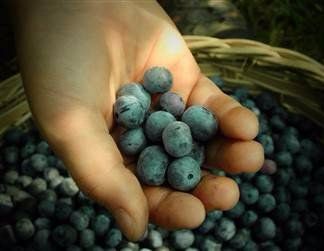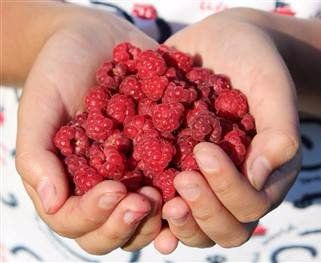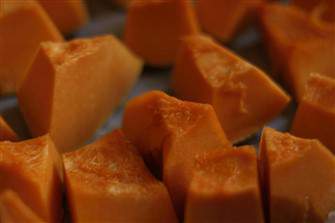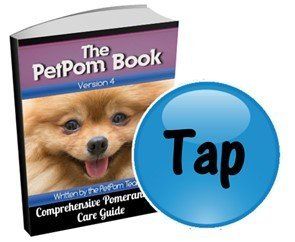Fruit
PetPom

The
Pomeranian
Information
Center
Fruits a Pomeranian Can, and Should, Eat
Overview
Maybe you’ve already chosen a great main kibble to give to your Pom & have taken time to find wholesome, healthy snacks, so what more is needed? Or opposite to that, maybe you’re a bit concerned that your Pom puppy or dog isn’t eating an ideal diet. In either of these two contrary cases and for every scenario in-between, there is one thing that should enter the picture: Fruit.
Why give fruit to a Pomeranian? There are lots of important reasons as to why. Fruits that are safe for canine consumption offer tons of vitamins and nutrients in a small package (low calories), are easy to dispense, can add just the incentive for a Pom to eat more if he’s a picky eater and most importantly, many fruits safe for dogs have antioxidants which are amazing substances that can play a huge role in preventing a host of disease and may even extend life span.
Since wholesome fruit should play a role in every Pomeranian’s diet, this section will cover all you need to know.
We will discuss:
- Top 8 Reasons why fruit is an awesome snack or addition
- The 4 best fruits for dogs (including nutritional info and recommended servings)
- Fruits that are not safe for canines to eat (if you think you know, please look again)
__1454016659_73-306x245.dm.edit_Ow5s1i.17.32.39-1920w.jpg)
__1454016659_73-306x245.dm.edit_Ow5s1i.17.32.39-1920w.jpg)
Snow, at 2 months old
Photo courtesy of Raktim Das
8 Reasons Why Fruit Can be Good for a Pomeranian
Just about every owner can identify with at least one of these elements. You just
can’t underestimate how beneficial fruit can be to a dog:
1. Packed with vitamins, minerals and nutrients.
Some fruits are healthier than others. However, many of the recommended ones are high in vitamin C. Many also have vitamin K, A, potassium, iron and/or zinc. Each of these plays a different role and once we start listing out the fruits to give to a Pomeranian (ahead), we’ll let you know which vitamins each contain.
2. Has antioxidants.
Antioxidants protect the body’s cells (human, dog or otherwise) from damage which can lead to a host of disease.
Bodies develop free radicals (which cause the damage) and antioxidants counteract those.
While more research needs to be done, it is thought that antioxidants (found in veggies and fruits) can play a role in preventing cardiovascular disease, diabetes, age-related muscular degeneration and even some cancers. It can also strengthen the immune system. In other words, they will help keep your Pom healthier & can extend life span.
3. Is low calorie.
In general, the Pomeranian breed does not have a problem with excess weight. However, it’s good to know that you can add fruit to your puppy or dog’s meals without adding a lot of calories. This will come into play more for the senior Pom that may have gained a bit too much due to being more sedentary.
4. Easy to dispense.
Many fruits that are good for Pomeranians are easy to work into the dog’s diet. They can be given as snacks and for those that tend to get mushy or are watery, freezing them is a great option to keep things tidy. Small pieces of fruit can easily be folded into meals and eaten along with the kibble.
5. Adds incentive to eat.
It is not uncommon for a Pomeranian to be finicky about his food and countless owners reach out to us asking what they can do to make their Pom eat more. While this breed's calorie requirements
are rather low to maintain (and therefore a Pom may be eating exactly the amount he needs to), for those that really need encouragement, mixing in some sweet, tasty fruit into a main meal can be just the thing to motivate a Pom to dig into his bowl.
6. Many have a low glycemic number
(this refers to how fast sugar is absorbed into the bloodstream) and the number is low for many fruits due to the fiber in them that counteracts the process. In other words, your Pomeranian cannot get a sugar high from a bit of fruit, you’d have to give him a lot for it to have a negative effect, sugar-wise.
When reading through, keep in mind that a score above 70 is high (bad), 56 to 69 is average and under 55 or less is low (good).


Keenai, photo courtesy of Rachael G.
Keenai
Photo courtesy of Rachael G.
7. Is the perfect treat to use for rewards.
When you’re training your Pom, whether that be for housebreaking, commands or heeling, it’s important to use treat rewards that are different from what the pup or dog normally eats.
If not, the motivation factor won’t be as high as it could be. Not only that, it has to be something the dog finds absolutely yummy.
What fits this bill? Fruit. Even if your Pom normally eats some of the ones listed below, once you see the entire summary of what canines can safely eat, you’re sure to find a few that your Pom will find special.
8. Is wholesome.
Looking to break free from those dog snacks loaded with chemicals (coloring, preservatives, flavoring)? Or tired of wondering what's made in the US and what's not?
Then, look no further than to fruit. While you do
need to properly rinse fruit to wash off pesticides, at least you know that you don't need to worry about all that other stuff.
***
If you're having trouble finding manufactured treats that are all-natural and made in the US, Fruitables Pumpkin & Banana Crunchy Dog Treats
 is a really great treat. It also comes in pumpkin and blueberry, cranberry, and apple.
is a really great treat. It also comes in pumpkin and blueberry, cranberry, and apple.
The 4 Best Fruits to Give to a Pomeranian
Before we jump into which fruits to start grabbing at the supermarket, let’s remember that moderation is key for any one food group.
Fruit is meant to be added in small amounts to meals or to given as snacks in small amounts.


Blueberries
– This is at the top of the list because it’s simply one of the best fruits to give to a dog. It's no secret how great this fruit is, as it’s the 2nd most popular berry aside from strawberries.
In terms of antioxidants, that is where this little tasty fruit shines: It is one of the highest antioxidants elements in the world, out of all the fruits, vegetables and seasonings that contain them.
There are many antioxidants found in blueberries and a good portion of those are due to their high phytonutrient content. Anthocyanins is one of those phytonutrients, it is the element that gives the fruit its nice, dark
color.
Not only can these help combat disease, they also act as a natural anti-inflammatory.
A lot can be lost during the cooking process, so you’ll want to stick with raw blueberries, preferably organic ones.
In human studies, regular consumption of blueberries was shown to improve memory and cognitive function. Though it remains to be seen if the same can be said for canines, we do know that this fruit can help prevent heart issues and prevent some cancers. Studies on animals have shown a reduction in breast, colon, esophageal, and small intestine cancers.
Nutritional values:
1/4 cup contains 22 calories. There is no fat, cholesterol or sodium. This fruit contains fiber, vitamin c, B6 and also has iron and magnesium. Its glycemic index (rate at which sugar is absorbed) is low with a score of 40.
Working blueberries into a Pomeranian’s diet:
This is a very versatile fruit, which makes it easy to give to a Pom. Do keep in mind that most dogs find fresh blueberries to be so delicious that you may find it best to plan ahead as to how you will incorporate these, so that a begging situation does not develop.
For adults, if you will be feeding
other fruits as well, try to stay with 1/4 cup per day. Puppies should have half this amount. You can give this as snacks either fresh or frozen (many Poms love frozen fruits on hot summer days and please note that studies have proven that freezing these does NOT change its healthy qualities; they can be frozen for up to 6 months).
These can also be mixed into food however, do be careful because the finicky Pom will take his time to selectively pick these out of his dish; you’ll want to mix them in thoroughly.
Raspberries
– These come a very close second to blueberries and are a great choice to give as a snack or to mix into a Pomeranian’s meals. While both types are a fantastic choice for canines, it should be noted that organic raspberries are far healthier than non-organic.
The antioxidant level in the organic type is much higher. Also, these offer the most benefits when fully ripe.
So, you’ll want to buy these when they are bright red and use them within 3 days at the most.
This fruit is well-known for its anti-cancer properties, due mostly to its anti-inflammatory phytonutrients.
Raspberries
– These come a very close second to blueberries and are a great choice to give as a snack or to mix into a Pomeranian’s meals. While both types are a fantastic choice for canines, it should be noted that organic raspberries are far healthier than non-organic.
The antioxidant level in the organic type is much higher. Also, these offer the most benefits when fully ripe.
So, you’ll want to buy these when they are bright red and use them within 3 days at the most.
This fruit is well-known for its anti-cancer properties, due mostly to its anti-inflammatory phytonutrients.

Studies with animals have shown that a diet consisting of raspberries alters the development/reproduction of cancer cells in regard to breast, cervical, colon, esophageal, and prostate cancers.
Nutritional values: 1/4 cup contains 17 calories. They contain Vitamin C, manganese, fiber, copper, vitamin k, biotin, vitamin E, magnesium, omega 3 fats, folate and potassium. The glycemic index of raspberries is a low 40, which is another great reason why this is a wonderful fruit to give to Pomeranians.
Working raspberries into a Pomeranian’s diet:
Like most berries, you can give some as snacks, work into meals (mix well) or use for rewards. If you will be giving other types of fruit to your Pom, stay with 1/4 cup for adults and 1/8 cup for puppies.

Pumpkin
– This is not a fruit that should be given to a Pomeranian on a regular basis, however it is super beneficial in certain circumstances and for that reason, it is here in the top 4 best fruits.
Please note that this refers to 100% real pumpkin.
At the store, you may see canned pumpkin pie filling that due to its labeling looks very similar to real 100% pumpkin, so do please double check that you do not
get the pie filling and get the fruit instead.
Let’s see what this amazing fruit can do for dogs:
1. Can help with upset stomach, diarrhea and constipation. Veterinarians often instruct owners to give pumpkin to dogs that are suffering from runny stools,
diarrhea (once they are back to eating solid foods after a short rest period) and to relieve constipation.
It helps with these conditions due to its soluble fiber. Do keep in mind that too much can have an opposite effect. For GI issues, you’ll only want to add 1 teaspoon for puppies or 2 teaspoons for adults to their bland diet of rice and plain chicken.
2. It can help lessen or stop coprophagia. This refers to when a dog ingests feces, his own or those of another animal (most often another dog or a cat).
While there are a variety of reasons why a dog may eat poop, including stress and a dieting lacking in proper nutrients (and those issues should be addressed), many owners have found that adding a spoonful of pumpkin helps the dog digest his food better and may alter the taste of feces once it is expelled; both of which can help combat coprophagia.
3. Weight issues.
Though rare, there are some Poms that are too heavy and for those that do need to lose a few pounds, vets often recommend pumpkin as one method to achieve that. It can help make a dog feel fuller, faster and longer, which can be of help when needing to cut back on calories.
Nutritional values:
1/4 cup of pumpkin has practically no calories: just 8. It also contains beta-carotene (vitamin A), vitamin C, B6, Iron and magnesium. It is a bit high on the glycemic scale (70), but low on glycemic load (3). What’s the difference?
The scale index number does not take into account that servings sizes of fruits and other foods vary. So, the number may be unfairly high. But when looking at the ‘load’, a number based on actual serving size of a particular
food, it scores well at just a 3 (under 5 is considered good).
Working pumpkin into a Pomeranian’s diet:
We would only recommend giving pumpkin to a Pom if the dog was having intestinal issues (diarrhea, constipation), has already been seen by a reputable veterinarian and has been properly diagnosed.
If this is the case, do ask your vet about adding pumpkin to your Pom’s diet to help him recover after a bout with those issues. For puppies a teaspoon or two and for adults 1 to 2 tablespoons are normally given to help calm the stomach down. You can mix this with plain white breast chicken meat and/or plain white cooked rice.
Also, if your Pomeranian is having a problem with coprophagia, it may be worth trying. One tricky thing about coprophagia is that some dogs respond well to one remedy while it has no effect on others… and a Pom may respond well but then build up a tolerance. So, pumpkin may be worth a try.
Mango
– The mango is a juicy stone fruit, that is native to South Asia. It is one of the most cultivated tropical fruits….
And while you might be surprised to see mango listed among the best fruits to give to a Pomeranian, it’s here for some good reasons.
This is a super safe, healthy food that offers tons of vitamins, is low calorie and is water-packed (it is 84% water).
Please note that like many fruits, the core of a mango is toxic.
Mango
– The mango is a juicy stone fruit, that is native to South Asia. It is one of the most cultivated tropical fruits….
And while you might be surprised to see mango listed among the best fruits to give to a Pomeranian, it’s here for some good reasons.
This is a super safe, healthy food that offers tons of vitamins, is low calorie and is water-packed (it is 84% water).
Please note that like many fruits, the core of a mango is toxic.
__1454018482_73-325x234.dm.edit_caVPkr.17.32.39-1920w.jpg)
Though it would take a lot of work for a Pom to nibble away to the center or bite through the core, please play it safe by only offering fresh chunks of mango that you slice off the fruit yourself.
Nutritional value:
1/4 cup of mango pieces is just 25 calories. There's lots of vitamins and minerals in mangos including: vitamin A, B, E, K and tons of vitamin C, beta carotene, riboflavin, niacin, folate, potassium and manganese. Of particular note is the level of vitamin C (36.4 mg per 100 grams). They are a close second to oranges
(53.2 mg per 100 grams).
Vitamin C is a powerful antioxidant that can: improve cardiovascular health, reduce cellular DNA damage that leads to cancer, is a natural antihistamine that can help relieve chest congestion and allergies symptoms, helps to keep skin healthy and even may reduce the risk of cataracts.
The folate in mango is needed for canines to produce healthy red blood cells and the vitamin B6 keeps skin, eyes and fur healthy.
Adding mango to your Pom’s meal plan:
With this one, you may find that hand feeding pieces can be a bit messy, so offering some cubes of mango in a small dish is often best. Though you may not immediately think that a mango would blend well into kibble, once a few pieces are added and its juices are blended throughout, this can be just the thing to encourage a Pom to finish his dinner.
Other Fruits a Pomeranian Can Eat


Brody
Photo courtesy of Jo Beth
There are lots of other fruits that puppies and dogs can eat. Do remember that moderation is key. Any food given too much becomes unhealthy.
Here is a list of all the fruits you can give to your Pomeranian without worrying:
- Apples (you may have heard to avoid these, but it is only the core and seeds that a dog can’t eat. Some apple slices are super healthy and completely safe to eat)
- Banana (a ton of banana can cause constipation, so just offer a few slices per day. Also dogs with Addison's disease or kidney disease should not be given bananas)
- Cranberries (these can help prevent and control urinary tract infections)
- Cantaloupe
- Kiwi
- Nectarines
- Oranges (high in sugar, so only offer a slice every now and then)
- Peaches
- Pears
- Pineapple
- Plums
- Strawberries
- Watermelon (this fruit is 92% water and great on hot summer
days when you want to make sure your Pomeranian is meeting his water requirements)
Technically Edible, but Be Wary
- Apricots – Due to the shape, size and difficultly level of removing the flesh from the pit (which is toxic), it is recommended to be weary
- Avocados – These contain a toxic called persin and this is highly toxic to cattle. It is not poisonous to dogs or to cats. Because it is so dangerous for larger animals, it always ends up on the ‘do not eat’ list for pets. So, if your Pomeranian eats some avocado, he’ll be just fine. This said, just the fact that it is on some many toxic lists, it can feel uncomfortable to break that taboo and give it as a snack. With so many other options, why not just skip this one?
- Olives – Technically a Pomeranian can eat a pitted olive, however these are very high in sodium and should not be fed to a dog for that reason. If your Pom eats a pitted olive by accident, he’ll be okay. If he eats an olive with the pit, the pit may have trouble passing through, so contact the vet.
- Tomatoes – For a long time the world debated if these were a fruit or a veggie. It’s been decided! Tomatoes are a fruit. Dogs can eat tomatoes, BUT the green leaves of these are highly toxic. If you have a tomato plant at home, keep this out of reach of your Pomeranian, but feel free to add some tomato to his meals.
Fruits Highly Toxic to Canines
- Coconut – Contains medium chain triglycerides which can lead to intestinal upset and bloating in some dogs.
- Cherries – It is so difficult to remove the fruit from the seed (and the seeds contain cyanide), that this is on the ‘toxic’ list.
- Currents – There are many different types; some are technically grapes, and therefore very toxic.
- Grapes – One of the most toxic foods in the world for canines. Very poisonous and can be fatal.
- Grapefruit – Due to the oils and psoralens found in this fruit, it is considered toxic. Ingestion can cause vomiting, diarrhea, depression, behavioral changes and/or photo-sensitivity.
- Raisins – Like grapes can be fatal if eaten.
A Final Word
No doubt, you’ve taken the time to carefully ensure your Pom is eating well. You search for and find the best food for your Pomeranian, and you plan out snacks and treats (making sure that they are made in the US and are free of coloring and chemicals).
It’s great to have your Pom on a super healthy, balanced diet, however it’s also wonderful to let a Pom learn about some new flavors while adding a boost of extra nutrition.

Ms. Beasley
Photo courtesy of Jo Beth
The benefits of some fruits are undeniable, so the next time you’re at the supermarket, why not pick up a small container of organic blueberries or raspberries… or when you peel a banana for yourself, freeze a few slices to give to your Pomeranian.
Your Pom will (silently) thank you for it and you can feel good that you’ve just contributed toward a healthier lifestyle for your canine family member.
Are you part of the PetPom family?
Become a Free PetPom Member so that you'll receive a friendly reminder when new pages of info to this site. You will also receive a fun & helpful Welcome Booklet.
You May Also Like:
Leaving a Pomeranian Home Alone
- Steps you can take to help your Pom do well when by himself.
Helping With Pomeranian Puppy Teething
- This can be a tough stage; for both owner and pup. See some steps you can take to make things easier.
You asked & we delivered!
See what's in the BIG, BETTER, PRINT EDITION of the PetPom Book.
If you email photos to us, you agree that PetPom is given free copyright to use at our discretion. We will always credit the photo to the name of the Pom's owner(s) if it is supplied.
Email: Contact@PetPom.com
All text, images and artwork protected by US and International copyright laws. All rights reserved. Copyright PetPom.com
We are a participant in the Amazon Services LLC Associates Program, an affiliate advertising program designed to provide a means for us to earn fees by linking to Amazon.com and affiliated sites.


